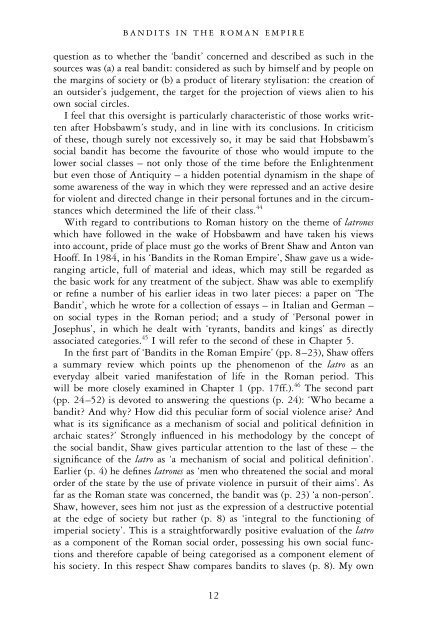Create successful ePaper yourself
Turn your PDF publications into a flip-book with our unique Google optimized e-Paper software.
BANDITS IN THE ROMAN EMPIRE<br />
question as to whether the ‘bandit’ concerned and described as such in the<br />
sources was (a) a real bandit: considered as such by himself and by people on<br />
the margins of society or (b) a product of literary stylisation: the creation of<br />
an outsider’s judgement, the target for the projection of views alien to his<br />
own social circles.<br />
I feel that this oversight is particularly characteristic of those works written<br />
after Hobsbawm’s study, and in line with its conclusions. In criticism<br />
of these, though surely not excessively so, it may be said that Hobsbawm’s<br />
social bandit has become the favourite of those who would impute to the<br />
lower social classes – not only those of the time before the Enlightenment<br />
but even those of Antiquity – a hidden potential dynamism in the shape of<br />
some awareness of the way in which they were repressed and an active desire<br />
for violent and directed change in their personal fortunes and in the circumstances<br />
which determined the life of their class. 44<br />
With regard to contributions to Roman history on the theme of <strong>latrones</strong><br />
which have followed in the wake of Hobsbawm and have taken his views<br />
into account, pride of place must go the works of Brent Shaw and Anton van<br />
Hooff. In 1984, in his ‘Bandits in the Roman Empire’, Shaw gave us a wideranging<br />
article, full of material and ideas, which may still be regarded as<br />
the basic work for any treatment of the subject. Shaw was able to exemplify<br />
or refine a number of his earlier ideas in two later pieces: a paper on ‘The<br />
Bandit’, which he wrote for a collection of essays – in Italian and German –<br />
on social types in the Roman period; and a study of ‘Personal power in<br />
Josephus’, in which he dealt with ‘tyrants, bandits and kings’ as directly<br />
associated categories. 45 I will refer to the second of these in Chapter 5.<br />
In the first part of ‘Bandits in the Roman Empire’ (pp. 8–23), Shaw offers<br />
a summary review which points up the phenomenon of the latro as an<br />
everyday albeit varied manifestation of life in the Roman period. This<br />
will be more closely examined in Chapter 1 (pp. 17ff.). 46 The second part<br />
(pp. 24–52) is devoted to answering the questions (p. 24): ‘Who became a<br />
bandit? And why? How did this peculiar form of social violence arise? And<br />
what is its significance as a mechanism of social and political definition in<br />
archaic states?’ Strongly influenced in his methodology by the concept of<br />
the social bandit, Shaw gives particular attention to the last of these – the<br />
significance of the latro as ‘a mechanism of social and political definition’.<br />
Earlier (p. 4) he defines <strong>latrones</strong> as ‘men who threatened the social and moral<br />
order of the state by the use of private violence in pursuit of their aims’. As<br />
far as the Roman state was concerned, the bandit was (p. 23) ‘a non-person’.<br />
Shaw, however, sees him not just as the expression of a destructive potential<br />
at the edge of society but rather (p. 8) as ‘integral to the functioning of<br />
imperial society’. This is a straightforwardly positive evaluation of the latro<br />
as a component of the Roman social order, possessing his own social functions<br />
and therefore capable of being categorised as a component element of<br />
his society. In this respect Shaw compares bandits to slaves (p. 8). My own<br />
12


